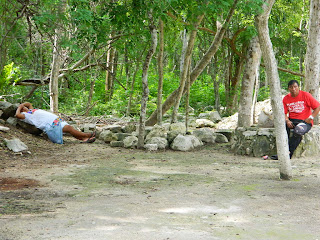Today we spent a full day site visit at Chichen Itza. Located adjacent to the pueblo of Piste, Chichen Itza sees over 3 million tourists each year. The people who service the tourists are primarily the Maya who live in Piste.
Each morning the vendors load all of their goods onto a bike (if they have one), or a truck (if they can afford to pay for one), or their back (if that's the only option) in order to make the trek to Chichen. Once they arrive it takes about an hour for them to unpack all of their sale goods. They often work in family teams so it's not unusual to see young boys and girls helping their parents or older siblings unwrap the day's wares.
 |
| Setting up in the morning |
 |
| During the peak of the day (note the young man in the green shirt in both photos) |
 |
| A family group setting up (note the boy in the yellow shirt; he is about 10 years old) |
Once set up, they wait for the tourists. Sometimes they work the crowd, calling out to passersby: "Barrato" which means cheap or "only one dollar" which usually ends up being more like ten dollars. Toward the end of the day, I heard one young man say in English "Cheaper than at Target." When I laughed and turned around to see his face, he said "Cheaper than Wal-Mart." He was laughing too. Clearly that's a young man who has been to the States at least once. Politicians often call him "illegal." I would call him "in search of an opportunity." Either way, he's working hard to make a living.
 |
| Waiting and watching |
Although many of the items the Pistenos are selling are made somewhere else (which means the Maya are once again being commodified in a giant capitalistic game they can never win), some of the families actually produce their own goods for sale.
Take the case of Hiram. He makes wood carvings and tie-dye t-shirts in the evenings after coming to Chichen and working his booth during the day. He also speaks, to varying degrees, eight languages which he has taught himself out of neccessity. When I spoke with him, he was friendly and open. He talked about how his t-shirts were still wet from last night's dying. He also shared the carving and staining techniques used on his wood carvings. The sculpture he is holding took him two days to carve and paint. I bought it off of him for $16 US. Hiram had a prosthetic leg, which can't make his life easier. I hope he made a killing off the tourists today.
Some of the men spend their time at the booth carving. Others nap or rest in the shade.
 |
| A woman napping |
 |
| Hiram |
 |
Juan
|
 |
| Reality |
One of our seminar leaders brought his son with him on the site visit today. The boy's name is Rafael. The juxtaposition of Rafael playing with his cell phone (age 7) seated next to the two little Maya girls (who look about age 7) resting in the shade during a hard day selling handkerchiefs was too poignant to resist. The location of one's birth determines so much about their lives. This is the story of the contemporary Maya. If these little girls desire to change the pre-determined course that's been set for their lives, they have a lonely and uphill battle against global forces. It's more likely that their lives will be similar to that of the woman's who is napping in the photo above.
Around 5:00pm, most of the crowds were gone and wardens for the park came running through on motorcycles, blowing a whistle and waving people to leave. It was time to pack up and head home. Another day at Chichen was over for the Maya of Piste.
 |
| Big man closing up shop |












While I appreciate the craftsmanship and entrepreneurship of the beautiful Mayan people, I wish that the vendors were located outside of the ruins (the park) as it takes away from the the serenity and surrealism of the ancient ruins.
ReplyDeleteYour pictures are beautiful!